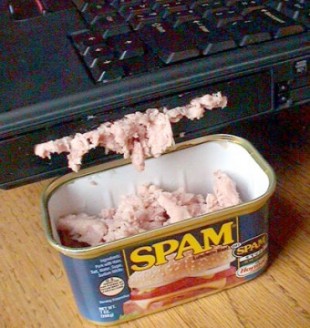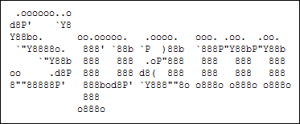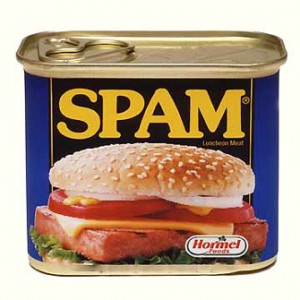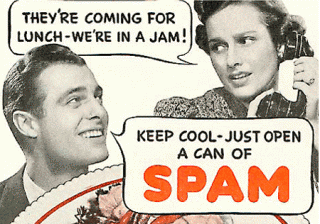How the Word “Spam” Came to Mean “Junk Message”
 Today I found out how the word “spam” came to mean “junk message” or “junk mail”.
Today I found out how the word “spam” came to mean “junk message” or “junk mail”.
While some have suggested that this was because SPAM (as in the Hormel meat product) is sometimes satirized as “fake meat”, thus spam messages are “fake messages”, this potential origin, while plausible enough on the surface, turns out to be not correct at all.
The real origin of the term comes from a 1970 Monty Python’s Flying Circus skit. In this skit, all the restaurant’s menu items devolve into SPAM. When the waitress repeats the word SPAM, a group of Vikings in the corner sing “SPAM, SPAM, SPAM, SPAM, SPAM, SPAM, SPAM, SPAM, lovely SPAM! Wonderful SPAM!”, drowning out other conversation, until they are finally told to shut it.
Exactly where this first translated to internet messages of varying type, such as chat messages, newsgroups, etc, isn’t entirely known as it sort of happened all over the place in a very short span of years, in terms of the name being applied to these messages. It is, however, well documented that the users in each of these first instances chose the word “spam” referring to the 1970 Monty Python sketch where SPAM singing was drowning out conversation and SPAM itself was unwanted and popping up all over the menu.
Some examples of these first instances of unsolicited/unwanted messages being referred to as spam:
- First documented case among Usenet users was March 31, 1993. This is often incorrectly stated to be the first usage of the term spam as referring to spam messages. This first Usenet case came when Richard Depew, who had been playing with some moderation software, accidentally ended up posting around 200 duplicate messages in a row to news.admin.policy newsgroup. The first person to call this spam is thought to be Joel Furr on March 31, 1993. Depew himself when he apologized referred to his messages as spam.
- A more likely “first use” of the word spam, referring to certain electronic messages, comes from MUDs (multi-user-dungeons). This was a sort of real time multi-person shared environment; a somewhat primitive version of The Sims Online or Second Life and the like. In it, users could chat and interact with other people, locations, and objects, as well as create objects and share them with the community. Basically a really advanced chat room. The name MUD comes from the fact that it reminded people of certain aspects of Dungeons and Dragons. In any event, spamming was used here to refer to a few different things including: flooding the computer with random data; “spam the database” by flooding it with new objects; and flooding a chat session with a ton of unwanted text. Basically, anything that had to do with filling other member’s accounts with unwanted electronic junk. One of the earliest documented uses of the word spam from MUDders comes from 1990 when they were, ironically enough, discussing the origins of the word “spam” as referring to electronic junk messages. Undocumented sources say it had been around quite a bit before that among MUDders, which is evidenced by the content of the documented message.
- Others say that the term originated on Bitnet’s Relay, which was a very early chat system in the 1980s. Supposedly, users would occasionally come on and annoy other users with unwanted text, including the actual SPAM SPAM SPAM song from Monty Python.
- Another similar chat system on the TRS-80 also reported the same phenomenon and also called it spam. Both these latter two chat system origins are not documented, but numerous former users of these systems have stated they remember this term being use commonly among users of these systems.
spam Spam SPam SPAm SPAM SPAM SPAM, lovely SPAM; Wonderful SPAM…
Bonus Facts:
 In the early days of the internet, spam was significantly more annoying than it is today, not just because of the lack of effective filters back then, but because of the extremely slow internet connections. Even just an ASCII art spam picture sent a few times in a row could take an enormous amount of time to download with often no real way for the end user to get around this except to wait it out or disconnect.
In the early days of the internet, spam was significantly more annoying than it is today, not just because of the lack of effective filters back then, but because of the extremely slow internet connections. Even just an ASCII art spam picture sent a few times in a row could take an enormous amount of time to download with often no real way for the end user to get around this except to wait it out or disconnect.- Also in the early days of chat rooms, it was a common tactic among chatters to use large blocks of meaningless text to annoy other groups. For instance, Star Trek chatters would invade a Star Wars chat room and post large amounts of random text, making it impossible for the Star Wars people to talk. NERD-FIGHT!!! 🙂
 Around the same time the term spam became popular among Usenet groups, it also spread to refer to email spam, which quickly dominated the world of spam and still does to this day. Early spam bots simply harvested emails from Usenet newsgroup messages, which gave them extremely large email lists to work from.
Around the same time the term spam became popular among Usenet groups, it also spread to refer to email spam, which quickly dominated the world of spam and still does to this day. Early spam bots simply harvested emails from Usenet newsgroup messages, which gave them extremely large email lists to work from.- IRC (Internet Relay Chat) was named after Bitnet’s Relay.
- The earliest documented commercial spam message is often incorrectly cited as the 1994 “Green Card Spam” incident. However, the actual first documented commercial spam message was for a new model of Digital Equipment Corporation computers and was sent on ARPANET to 393 recipients by Gary Thuerk in 1978.
- The famed Green Card Spam incident was sent April 12, 1994 by a husband and wife team of lawyers, Laurance Canter and Martha Siegal. They bulk posted, on Usenet newsgroups, advertisements for immigration law services. The two defended their actions citing free speech rights. They also later wrote a book titled “How to Make a Fortune on the Information Superhighway“, which encouraged and demonstrated to people how to quickly and freely reach over 30 million users on the Internet by spamming.
- Before it was called “spamming”, as referring to unsolicited messages in a chat or forum or the like, the generally used terms for these actions were “flooding” and “trashing”.
- Cisco Systems, in 2009, released the following numbers for the origins of spam by country in descending order: Brazil at 7.7%; USA at 6.6%; India at 3.6%; South Korea at 3.1%; Turkey at 2.6%; Vietnam at 2.5%; China at 2.4%; Poland at 2.4%; Russia at 2.3%; Argentina at 1.5%. Surprisingly, you have to go all the way down to number 91 on the list before you get to Nigeria.
- Of all email spam, about 73% is attempting to steal the user’s identity in some way (phishing), including possible bank information or gaining enough information to open new credit accounts from the user.
- Of the 90 trillion emails sent in 2009, 81% were spam. That amounts to about 200 billion spam emails sent every day.
- Though not called spam, back then, telegraphic spam messages were extremely common in the 19th century in the United States particularly. Western Union allowed telegraphic messages on its network to be sent to multiple destinations. Thus, wealthy American residents tended to get numerous spam messages through telegrams presenting unsolicited investment offers and the like. This wasn’t nearly as much of a problem in Europe due to the fact that telegraphy was regulated by post offices in Europe.
- Spam, referring to messages, rather than the food product, was first added to a major English dictionary in the New Oxford Dictionary of English in 1998. It defined spam as “Irrelevant or inappropriate messages sent on the Internet to a large number of newsgroups or users.”
 SPAM, as made by Geo. A. Hormel & Co. was originally registered as a trademark in 1937, being a conflation of “spiced ham”, which was the original name. The name “SPAM” was chosen from entries in a naming contest at Hormel. Specifically, the name was suggested by Kenneth Daigneau, who was the brother of a then Hormel Vice president. He was given $100 prize for winning the naming contest.
SPAM, as made by Geo. A. Hormel & Co. was originally registered as a trademark in 1937, being a conflation of “spiced ham”, which was the original name. The name “SPAM” was chosen from entries in a naming contest at Hormel. Specifically, the name was suggested by Kenneth Daigneau, who was the brother of a then Hormel Vice president. He was given $100 prize for winning the naming contest.- If you are wondering why I’m continually capitalizing all the letters in the food product SPAM, it is because, according to the official Hormel trademark guidelines, SPAM, as referring to the food product, should be spelled with all capital letters. They also stipulate it should always be used as an adjective as in “SPAM meat”, but I’m ignoring that one and just calling it SPAM. 🙂
- Hormel was able to successfully defend their trademark of SPAM by limiting it to this capitalized version; thus the more prevalent usage and meaning and spelling “spam” and “Spam” referring to internet messages, doesn’t conflict with their trademark. Initially, they unsuccessfully defended their trademark by including “Spam”, but lost that case and resorted to “SPAM”. Hormel states that “Ultimately, we are trying to avoid the day when the consuming public asks, ‘Why would Hormel Foods name its product after junk email?”
- Other backronyms surrounding SPAM are: “Something Posing As Meat”; “Specially Processed Artificial Meat”; “Stuff, Pork and Ham”; “Spare Parts Animal Meat”; and “Special Product of Austin Minnesota”.
- Backronyms surround internet spam include: “stupid pointless annoying messages” and “shit posing as mail”.
- When the US offered the UK citizens affected by WWII SPAM, while they struggled to rebuild their agricultural base, the British citizens assumed it was an acronym and they backronymed it to “Specially Processed American Meats”.
- SPAM is a canned, precooked meat product (originally ham, but now SPAM from a variety of meats is available).
- Austin, Minnesota is known as “SPAM town USA”, not for internet spam, but for the fact that the town produces all of the food product SPAM sold in North America, South America, and Australia. SPAM sold in the UK is produced in Denmark by the company Tulip, who Hormel has licensed its production out to.
- As of 2007, over seven billion cans of SPAM have been sold.
 Hawaii, Guam, and the Commonwealth of the Northern Mariana Islands eat the most SPAM per capita in the United States, with an average of about 16 tins per year eaten per person.
Hawaii, Guam, and the Commonwealth of the Northern Mariana Islands eat the most SPAM per capita in the United States, with an average of about 16 tins per year eaten per person.- Hawaii, Guam, and CNMI, all have McDonald’s restaurants that serve SPAM. Burger Kings in Hawaii also serve SPAM since 2007 to better compete with the McDonalds there.
- SPAM is also nicknamed “The Hawaiian Steak”, due to its extreme popularity there.
- The term spam today is poised to take another slight shift in meaning. It is now becoming common for people to refer to any unsolicited/unwanted advertisements, messages, or telemarketer calls as spam, even if the former two aren’t electronically based.
| Share the Knowledge! |
|





The term “cookie”, meaning a bit of data a website leaves on your computer to help in tracking you and your use of the site, is short for “magic cookie”.
.
It probably derives from the magic cookies Fred Bird got stoned on in Dan O’Neill’s 1960s/70 hippie comic “”Odd Bodkins”.
.
The first use of the term “virus” for a program that attacks computers and spreads it to others is in David Gerrold’s 1971 SF novel “When HARLIE was One”.
.
The earliest reported use of the term “worm” meaning a program that attacks computers was in John Brunner’s SF novel “Shockwave Rider”.
Wow, that’s quite the back story behind the word spam lol. I enjoyed the history lesson it brought about some feelings of nostalgia.
Nonsense. In the early days of the internet it was possible to send email to everyone on the system. These system-wide emails were referred to as “SPAM”, meaning Send People Alotta Mail. The monty python story is an urban legend.
@archangel: sources?
Bull.
That’s like the Roman-chariot-ruts-cused-railroad-track-width.
The Python etymology is almost certainly correct.
I have agree that the Python etymology is the correct one.
I ran a dial-up BBS from Nov. 1988 to Oct. 2000 and remember the term (and the admonitions) on FidoNet (a point-to-point email delivery system) back in the day.
Yep. Agreed. I ran a dial-up BBS in North Dallas starting in 1987. I remember it well.
Nonsense. The term spam for junk mail did derive from the Monty Python skit.
The TRS-80 (or Trash 80 as we sometimes called it), was a computer system built by Tandy corporation and sold through Radio Shack.
It was not, in and of it’s-self, a “chat system”.
Thank you. Yes, I couldn’t figure out what he was talking about. The TSR-80 was a computer.
I never saw any plausible connection to Monty Python other than a fondness for silliness. There was a CMU online discussion where it was used, based on the movie “The Right Stuff”, so that would be 1983. The astronauts didn’t want to be non-productive “spam in a can”. This at the time only referred to posts that don’t further the argument, such as a “me too”.
I wanted to call the bad stuff “Persistant Unsolicited Comercial Email” or PUCE. It didn’t catch on.
I know nobody is going to believe me but, in the old days of BBS, dial up and VHS tapes I borrowed my brothers Monty Python tape. I was in college at the time and had a 1200 baud modem. At the time AOL was mailing out anybody a floppy of their BBS client software. (which as super easy to hack) After watching the video I went on to the (I believe) the Star Trek chat room on AOL with the chat name davidmidi. And asked what is SPAM? Simple question. The answer was meat. I then asked what does it stand for? The room went wild with decoding for the acronyms. Shortly after people just typed in spam over and over again copy any pasting until the room could not be used. It quickly ran over into other chat rooms on BBS’s all over the world. Like I said you do not have to believe me but it is the truth.
I remember a odd little Mac gamelet that bounced a picture of a can Spam around the screen along with a sound clip of the word Spam from Monty Python. When you clicked on the can it disappeared only to pop up again.